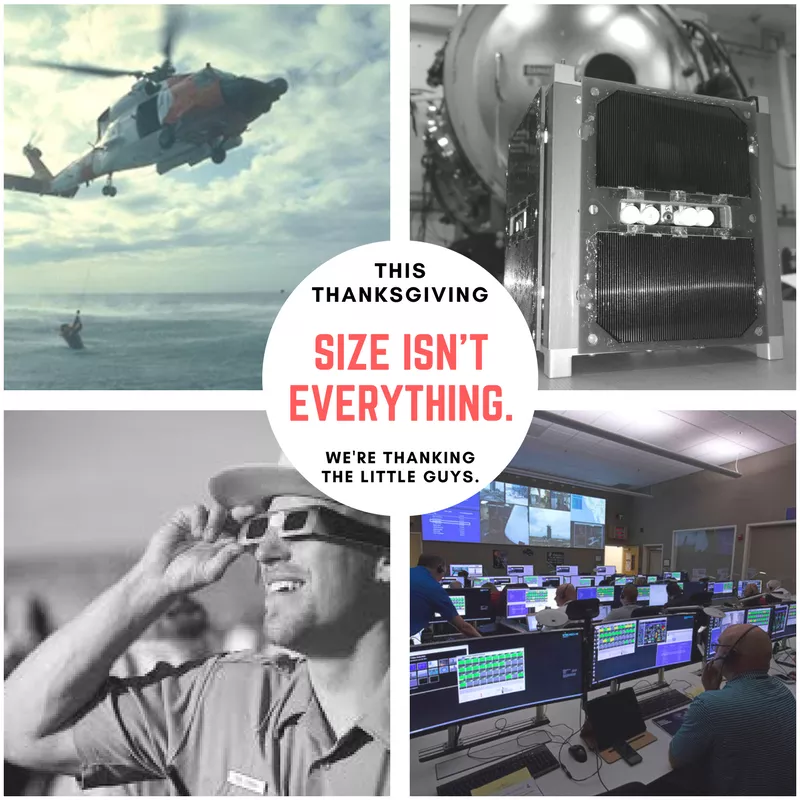NOAA satellites tend to see the ‘big picture’ a lot. Looking at Earth from 22,240 miles back (GOES-16’s home in the sky), allows us to see some really big things to be thankful for all the time. So this Thanksgiving we thought we’d take a much closer look at some of the smallest things we appreciate here at NOAA. This Thanksgiving, NOAA’s Satellite and Information Service team wants to thank the little guys.

Thank you Personal Locator Beacons,
Thank you Personal Locator Beacons (PLB), small enough to fit into the palm of your hand, for allowing individuals lost anywhere in the world to be found by NOAA’s Search and Rescue Satellite Aided Tracking (SARSAT) team. These beacons are available for purchase and their distress signals can be activated in times of need. All PLBs have a built-in, low-power homing beacon that transmits on 121.5 MHz. This allows rescue forces to home in on the distress beacon once the satellite system has provided the necessary position information. Some PLBs also allow GPS units to be integrated into the distress signal. This GPS-encoded position dramatically improves the location accuracy down to the 100-meter level…that’s roughly the size of a football field.
Thank you CubeSats,
Thank you CubeSats for being the smallest members of our mighty satellite fleet. CubeSats can be attached to a larger satellite mission and used for educational, research and development purposes, like those that accompanied the spacecraft inside the Delta II rocket that launched JPSS-1 into space on November 18th. The JPSS-1 satellite carried NASA sponsored CubeSats for four universities whose mission objectives include STEM engagement, technology development and research into the effects of space radiation on semiconductor memory hardware. The CubeSats launching with JPSS-1 include: EagleSat, MakerSat, MiRaTA & RadFxSat. These tiny satellites provide shorter construction times and reduced costs. As the technology improves, NOAA will continue its partnership with NASA in an effort to use them operationally in the future. The average CubeSat (also called a nanosatellite) measures four inches per side, and weighs just 9.3 lbs., which is still 5 lbs. shy of the average Thanksgiving turkey at the dinner table.
Thank you Rocket Launch Stop Button,
Thank you Rocket Launch Stop button on the Launch Conductor’s console for allowing a ‘hold’ to be called on a rocket launch right up to the time of launch. This year the Delta II rocket, holding over 5,000 pounds of the most advanced polar satellite technology now orbiting the world, called NOAA’s JPSS-1, had its launch held twice due to sub-optimal weather conditions. Thankfully we are able to set up safety mechanisms to control the 128-foot Delta II 7920 rocket, which consists of a booster stage, hypergolic second stage, nine solid rocket motors and a 10-foot diameter payload fairing, so that the rocket and the JPSS-1 satellite are always safe throughout the launch countdown.
Thank you ABI Visible Channel Detector Pixels,
Thank you ABI visible channel detector pixels for sensing light and converting radiance into an electrical signal that can be digitized and transmitted from the NOAA GOES-16 ABI instrument in space to weather forecasters on the ground! Each pixel is just 13 micrometers wide and 11 micrometers tall. There are 1460 of them and together they take the fabulous, high-resolution pictures of Earth that ABI is famous for. Small things make a big impact!
Thank you Personal Computing Device,
Thank you personal computing device for allowing @NOAASatellites to communicate with over 1 million followers around the world to share not only critical weather and environmental imagery, but also our love of science, and this amazing planet, Earth!
Happy Thanksgiving!